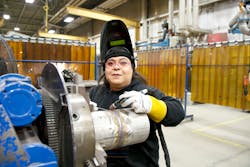It looked like an erupting volcano, says Celia Reyes when describing watching her dad weld for the railroad and in their garage when she was a kid. When she decided to follow in her father’s footsteps in pursuing the same career path, she would be met with a number of challenges.
In a starting class of 150 students at Tulsa Welding School, Reyes was one of only two women; she later graduated with only 10 others from the class.
“I had a lot of people tell me in the class there, since there were so many guys, they’re like, ’What are you doing here? You’re not supposed to be welding. You’re supposed to be at home cooking and cleaning and having kids,’” she says. “I’m like, ‘No, I’m here to do what you do. And I’m here to learn.’”
In the professional world, Reyes says she still had to prove herself to her colleagues, despite her training. “It was a struggle. Definitely. Since it’s such a male-dominant industry, you just have to keep on going.”
Regardless of the obstacles they may face, Reyes is on a path to show that women can have successful and fulfilling careers in the skilled trades. “It’s rewarding because you make good money, and it makes you feel good.”
According to the American Welding Society’s weldingworkforcedata.com, just 5% of welders are women. Reyes says running into another woman in welding is like seeing a unicorn.
So, how do encourage more women to get involved in these careers? Additionally, what can companies and women gain from increasing representation in skilled trades?
The How
Creating/Changing Perspectives
“Diversity generates new ideas … In order to provide innovation, you need to hear different people’s perspectives,” says Vanessa Li.
Li is on the board of directors for the Women in Manufacturing Education Foundation (WiMEF), a nonprofit committed to advancing women in the manufacturing workforce.
One of the first steps would be creating visibility where it may not have existed before, says Li. “I think by doing outreach work in local schools, it helps them understand more about what is available. If you’ve never heard of it, there's no way you can read more about it. And if you don’t know it exists, you wouldn't say, ‘Hey, this is an area, I want to explore.’”
Examples of increasing visibility include educating on career paths that don’t require a traditional four-year degree and showcasing role models of women in skilled trades, she says.
“It could be hard to have a family day event in the manufacturing floor, but maybe show some videos or have women talk about why they enjoy such-and-such work. Because you hear a lot of women talk about their career as a doctor or lawyer and stuff like that. But comparing with manufacturing, you don’t hear that much,” she says.
And for those who already think they know about manufacturing, Li emphasizes taking a closer look to understand the primarily skewed version of industry that is often portrayed.
“People may have the idea that, ‘Oh, manufacturing is dirty, it’s dangerous, it’s not safe.’ So that may not be something that people will naturally recommend … But nowadays, there are a lot of initiatives such as sustainability, carbon reduction and a better workplace environment.”
Changing the Culture
Aside from disproving misconceptions about skilled trades, industry must create an environment that is not only inclusive, but welcoming. Li cites examples such as writing more gender-neutral job descriptions when recruiting and being open to accepting women coming back to the workforce from a career break.
However, the work is not done once women have been hired. Companies must support those new workers. One specific example: making sure women have proper-fitting uniforms that eliminate potential safety issues, Li says.
Creating equity is a process that requires male allies from the bottom to the top. Not only do women need support from others on the plant floor, but they also require an inclusive culture perpetuated by leaders that advocate for them.
If senior management, typically made up of more men than women, doesn’t prioritize gender inclusivity in the workplace, the same sentiment can trickle down to the employees and HR, making it difficult for organizations to seek out and utilize marginalized talent to their advantage, she says.
The Why
Addressing Worker Shortages
“Young people today, in general, aspire or will consider a career if they can relate to someone that’s already in that industry,” says Monica Pfarr, executive director of the AWS Foundation, the philanthropic arm of the American Welding Society. “While there are many young people who have family members or role models, individuals who are in the skilled trades, many do not. And, they’re just not aware that the skilled trades or welding [are] potential career opportunit[ies]. So, we’re trying to share stories.”
The AWS Foundation has three main goals, says Pfarr: scholarships, grants and workforce development. While the AWS Foundation predictably focuses on welding, its principles reflect the push and resources needed to encourage women to pursue any skilled trade.
With a global workforce shortage, especially in the skilled trades, Pfarr says now is a perfect time to focus on people who aren’t well represented in industry.
“If we want to help address the shortage, we should be really promoting careers in our industry to women, making sure that they feel welcome in the industry, that they’re knowledgeable about what it is to work in welding, that they feel that they understand what kind of education and training is needed.”
Delving deeper, just 30% of welders are non-white or of multiple races, according to weldingworkforcedata.com. Pfarr emphasizes that encouraging these careers to other demographics can create more ideas, perspectives and opportunities that will lead to company innovation.
Career Opportunities
All of these ideas sound great on the business side, but what will incentivize women to see these careers as a viable option. What’s in it for them?
“These are well paying jobs in manufacturing and construction and welding. But there’s also a lot of opportunity for growth. And so, if a woman aspires to move up in their career, there are a lot of opportunities to do that,” such as furthering their education and moving into more advanced positions, Pfarr says.
She adds that since workers are in such demand, there is job security in skilled trades. “Looking at the future … it’s not like manufacturing, we’re all of a sudden not going to have a need anymore. There’s continued growth.”
Pfarr concludes with a piece of advice to anyone considering a path in the skilled trades.
“It can’t hurt to give it a try, right? So, take that first welding class … It doesn’t mean that you have now made the decision that that’s what you’re going to do for a career, but you don’t know what might really spark your interest or what might really be your passion if you don’t give it a try,” she says.
Celia Reyes echoes the same sentiment, speaking on how she finds meaning in her work.
“You see something that comes to life” from a paper design to a finished product, Reyes says. “And then you learn about what it does in the field or what it is that you create, and you’re like, ‘Wow, that’s pretty cool, that is very meaningful.’”
About the Author
Anna Smith
News Editor
News Editor
LinkedIn: https://www.linkedin.com/in/anna-m-smith/
Bio: Anna Smith joined IndustryWeek in 2021. She handles IW’s daily newsletters and breaking news of interest to the manufacturing industry. Anna was previously an editorial assistant at New Equipment Digest, Material Handling & Logistics and other publications.


